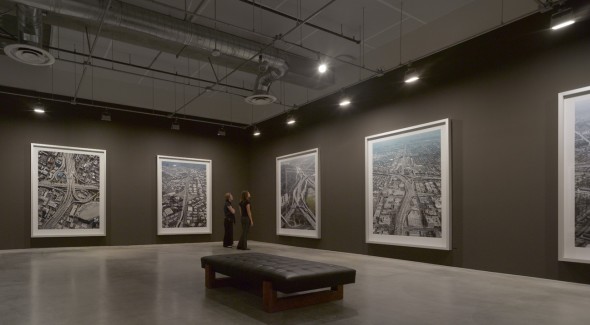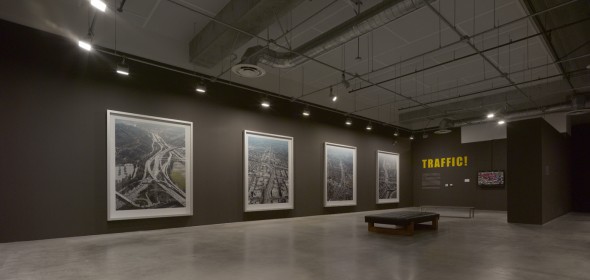Showing at the Pasadena Museum of California Art, 5/30/09-9/20/09.
Showing at the Wolfsonian in Miami, 10/16/09-1/21/10.
In 2003, driving to my first Los Angeles gallery opening in Chinatown confronted by a massive traffic jam, I became nostalgic for the early nineties when I moved to Los Angeles from Hawaii and the streets were far less congested. Two weeks after the opening I was at lunch with the gallery owner and my curator and I told them how profoundly affected I was by the escalation in traffic, and how the experience continued to trouble me. To help me make sense of it and to bring it to the attention of others, I decided to undertake an art project. After muchcontemplation, I began by trying to photograph freeways and overpasses from another car, but that didn’t adequately convey the scale of the backup. Eventually I concluded that aerial photography was the most suitable medium to express this otherwise incomprehensible scale; the only method capable of documenting and capturing rush hour traffic in its enormity.
Concurrently, I discovered a deeper meaning behind the traffic. Traffic jams in a megalopolis such as Los Angeles are both a reflection of contemporary society’s inability to comprehend scale in terms of change rate relative to time, and a function of enormous population growth’s impact on our ability to deal with that scale. This scale issue is a microcosm of other crises threatening our continued existence such as climate change, exploitation of resources, and ourfood shortage crisis. A reluctance to acknowledge the magnitude of these crises and takeaction sooner underscores the degree of our complacency, procrastination, and greed. Now that the problem is so pervasive, solutions will naturally be more difficult and more costly. My intention with this project is to render the situation visible in a manner that will be simple to comprehend, yet have a powerful impact on the viewer.
TECHNICAL NOTES
To most accurately represent the extent of a traffic jam, I chose to photograph the project from above, using a helicopter and a fixed-wing aircraft from different altitudes, ranging from 1500 to 5000 feet. However, the photographic representation of a large-scale traffic jam presents a technological challenge. In a 16 x 20 inch photograph, a one-mile stretch of freeway would be reduced to a thin line, radically reducing the visual impact if one cannot see the individual cars trapped on the freeway.
The ideal size would be a much larger, 6 x 8 foot print. Producing a print that size by enlarging small format film or by using a digital camera would unavoidably result in a pixilated mosaic or an image grainy beyond recognition. To most realistically convey the near-dystopian condition of our freeways, the photographs must be printed at the highest possible resolution. This is where I encountered the first of many challenges. These enormous prints require large-format negatives to yield high-resolution details that cannot be achieved through any commercially available digital camera and – a possible solution – reconnaissance satellites, are inaccessible to me.


